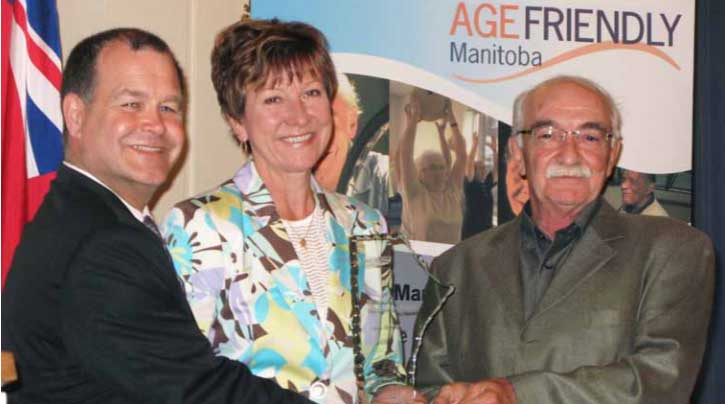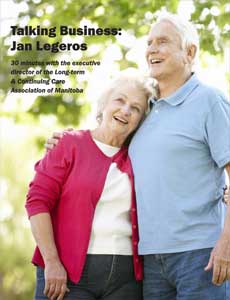Liniform Service
30 minutes with the executive director of the Long-term & Continuing Care Association of Manitoba
The Long-Term & Continuing Care Association of Manitoba is a membership-based, not-for-profit organization that has been representing healthcare providers since 1959. It is incorporated under the Companies Act of Manitoba and has recognized bylaws. Its volunteer, member-elected
Board of Directors provides the overall governance for the association, while full-time professional staff manages the daily administrative duties. The membership of almost 100 represents many industry leaders as well as more than 4,500 long-term and continuing care beds/suites. It represents nonprofit (49 percent) and private (51 percent) personal care homes, supportive housing residences and retirement (or independent living) residences, spanning all five regional health authorities across Manitoba.
The purpose of The Long Term & Continuing Care Association of Manitoba is to advance the delivery of quality long-term and continuing care services and resources, through advocacy, education and networking for our members and those they serve.
The Association believes it has a solid working relationship with several of the new regional health authorities. The Manitoba Government has provided a link on its website to the LTCAM website, in recognition of the valuable public service LTCAM provides through its one-of-a-kind navigation section on Seniors Care and Living Options.
LTCAM has been very successful in working as the agent for the service purchase agreements for both long-term care and supportive housing. It is also part of the Provincial Coalition for Excellence, Diversity and Innovation in Patient, Resident and Client Care, which has been meeting with government to discuss Bill 6.
Executive Director Jan legeros represents the association on a number of important committees, including: • The Manitoba Network for the Prevention of Elder Abuse; • Community Housing with Services Review Subcommittee – Advancing Continuing Care “A Blueprint to Support System Change,” reporting to Manitoba Government;
• Age-Friendly Manitoba: Chair of the Village of Dunnottar Age-Friendly Committee (This Community received its official Age-Friendly designation from Minister Rondeau in June 2012. The Committee has also received letters of commendation from the Public Health Agency of Canada and the World Health Organization, for the community initiatives it has completed since its inception in September 2011; and
• The Canadian Alliance for Long-Term Care: Board Executive examples of its strong partnerships with organizations throughout Manitoba are: • Alzheimer Society of Manitoba invited LTCAM to be a part of their “We Have a Dream” video. LTCAM has also been invited to present at its public forums on care and living options.
• Provincial Age-Friendly Communities events – LTCAM ED – presenter, focusing on Age-Friendly partnerships with surrounding communities.
• Ageing Secretariat – LTCAM’s services are included in the Ageing Secretariat Age-Friendly Seniors Guide.
• Annual Provincial Conference and Exhibition – LTCAM hosts this conference where more than 500 attendees and industry leaders from across Canada, as well as neighboring provinces, gather to learn more about long-term and continuing care. Last May, we welcomed the Minister of Healthy Living and Seniors as our host and emcee for the Provincial Awards For Excellence ceremony.
• Our website is published in English and in French, and our major new releases and other important correspondence are also sent in both languages. Our website receives over 15,000 page views, monthly. Website Links to the LTCAM website are found on many other organizations’ as well as Government websites. For example: RHAs, Province of Manitoba Age-Friendly Website, A & O Support Services for Older Adults. • Numerous Government departments, organizations, RHAs and other associations refer the public to our “Where Do I start” navigation section and/or our toll free line. The LTCAM website offers a one-of-a-kind, “Where Do I Start” navigation section that guides one through the options when a person or a loved one needs services, assistance, or care. We offer extensive information, education and guidance to the general public on a daily basis.
Business View: Talk about the organization’s founding. What were the catalysts to it starting?
Jan Legeros: It began as a group of private citizens who got together to provide care for seniors in the early 1950s. At that time, there were no care homes. These private citizens opened their homes and began to fill the huge need for care. They developed their own quality improvement standards and took turns reviewing each other’s homes, documenting the results for future improvements. They lobbied government to pro provide funding to seniors for care. Finally in 1972, long term care residences became an insured health service for all seniors.
Business View: how has the Association’s core role evolved since then, or is it similar simply with different market conditions and dynamics?
Legeros: It has evolved dramatically, as mentioned, in terms of scope of membership, creation of a website, building strong relationships with other like-minded organizations, Regional Health Authorities (RHA) and Government. We have the only “Navigation Tool” for the public on our website. We receive referrals from the RHAs and Government to help people navigate the health system.
Business View: What is your membership these days/how is it broken down by membership type?
Legeros: We had 26 members in 2007 and we now
have almost 100. Membership is much more diverse.
Business View: have there been trends up or down?
Legeros: No. Just a steady escalation.
Business View: What does the typical member look like and what are the usual benefits they’re seeking?
Legeros: We have three categories of membership each with their own specific set of services. Most members are looking for support, promotion, problem solving and networking.
Business View: Are there other groups/organizations competing for the same people?
Legeros: No. While there are many like-minded organizations, none has the depth and breadth of services that we offer.
Business View: What do you consider the association’s primary driver – networking, advocacy, training, etc.?
Legeros: All of the above. For example, our Association promotes and facilitates education, training, policy development, and networking for members. We also act as the agent to negotiate, on their behalf, contracts with the Regional Health Authorities. The Association is invited to sit on provincial committees and is consulted on major health care events and studies.
We hold an annual Provincial Conference and Exhibition for Long-Term and Continuing Care that attracts an average of 400 delegates. It is the only one in MB and SA. Last year our exhibit hall was sold out over a month before the conference. More than 90 companies and organizations exhibited. Our satisfaction score was 89 percent, overall.
Business View: regardless of size or type, are there common issues members are facing?
Legeros: Yes. The major challenge for everyone, wheth
er it is Retirement Residences, Supportive Housing or Personal Care Homes, is keeping our residents safe, and making their “home” wherever it might be, truly feel like their home with the limited resources available.
Business View: What are your primary engagement strategies and how effective are they – publications, events, etc.? how engaged a group is it, on average?
Legeros: Our primary engagement strategies are communication, networking and lobbying. These strategies are extremely effective. For example, we sent an Open Letter to the Minister this week, announced it to our members and within hours, 1,600 people had visited our website to read the letter.
Business View: What are the main association objectives in the future?
Legeros: As an organization we continue to foster longterm care leadership through membership growth, development and support.
our 2012-2015 Strategic directions are:
1. Position LTCAM as the “go to” Association to collaborate on long- term and continuing care policy and service delivery. The Association’s overall goal is to become the “go to” provincial association for the longterm and continuing care continuum in Manitoba. To become a credible voice and hence fully represent its members’ needs, LTCAM is called to increase its involvement with the Province and RHAs in addressing priority policy and service delivery issues. In doing so, LTCAM must seek to identify and act on rallying issues that align with its members’ as well as the Province’s and the RHAs’ priorities.
2. Provide relevant, value-added services for the Association’s members. LTCAM exists to support its membership in providing quality care, services and resources. In terms of both recruitment and retention, LTCAM needs to continue to support members and pay attention to their stated priorities (e.g. capital renewal, consistent reporting). Members – actual and potential – must see value in LTCAM. One of LTCAM’s value-added services is the provision of information to the general public on long-term and continuing care options.
The ability to provide relevant member programs and services (to respond to growing and changing needs) is also influenced by available resources – financial, human, technological and physical. Resource development is important in this context. LTCAM’s ability to retain current membership and recruit diversity of members will also promote its credibility


